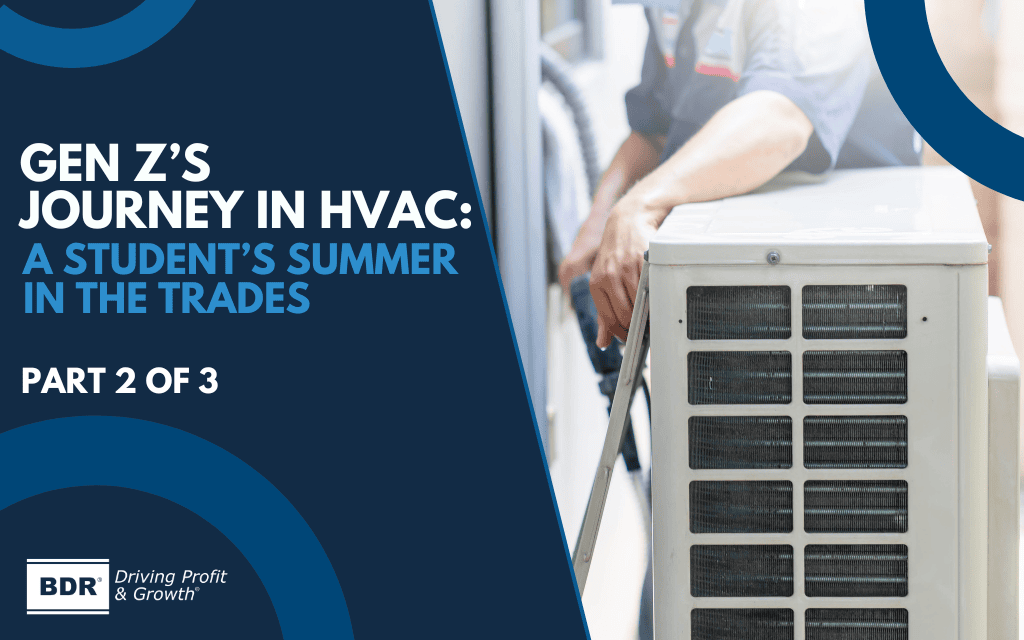GEN Z’S JOURNEY IN HVAC: A Student’s Summer in the Trades

Welcome back to part two of the article series about my summer working in the HVAC industry as an Install Helper.
The Work
The HVAC industry involves a wide variety of work and effort to make the magic happen. At the shop itself, the day is filled with fabrication. The hum and whirl of machines fill the air. The offices are abuzz with calls, conversations, and planning. When I started, I was lost in this bustling warehouse. Within a month, though, I knew my routine.
- Arrive on time.
- Check the board to see what job I was on.
- Connect with my senior partner for the day.
- Get to work!
Residential
A day of working residential jobs starts by loading a van or truck with an air conditioning unit, line set, and various other parts one may need. We are given an address, and we head out there as soon as we can. Once we get to the house, we talk with the homeowners and give them a rundown of our plan, making sure everyone is on the same page. After that, it’s time to get down to business.
My responsibilities for residential jobs, which could vary heavily from day to day, included leveling out the ground on which the unit would be placed, gluing PVC pipe together, and helping remove the old unit and placing the new one. Each residential job has its own unique bit of problem-solving.
Where I excelled was the “crawl.” Through an access inside, I would crawl under the house, my headlamp illuminating the darkness for me. Now, it’s not pretty down there, but it’s an interesting challenge. On my hands and knees, I’d squeeze my way through a labyrinth of concrete and pipes, trying to avoid the refuse of animals and the dens of spiders. I was the man on the inside, and I’d communicate with my partner through the walls (or attempted phone calls) where it was safe and smart to drill holes. From there, my partner would shove the lineset through a hole, and I’d drag it to where it needed to go, doing my best to navigate the straightest route and not kink the copper. When I popped back up from the underground, I’d be covered in sweat and grime, eager to breathe fresh air once again. My senior partner would often do me the kindness of treating me to lunch after that.
After lunch, we’d get back to it. My partner

would weld, and I would gopher for him if need be. If the lineset was visible and ran alongside the house, I’d install a cover so it was not exposed. I’d also devote a fair amount of time to cleaning up our mess. I strove to remove any nails, sawdust, and scraps of metal that we had created. When working with homeowners, the campfire standard is the golden rule. Leave the area the same or better than it was found. It can seem small, but whenever I put the effort into cleaning the area and being thoughtful, homeowners notice and give sincere thanks and compliments. Having positive interactions with the client base not only gave me a sense of satisfaction, it reflected well on my employer and helped ensure repeat business.
Commercial
Like residential, we’d start a day of working a commercial job by loading our van with the needed materials. Often, I would fabricate the pieces we needed, such as drive and angle, before we headed out. While the shop does a great job of staying on top of making what’s needed, it sometimes takes someone who’s been at the site to know what needs to be made now and what can wait till later.
My tasks in commercial jobs started on the simple side, like insulating the supply duct. Now, this is an easy task in theory, but it was often complicated by what surrounded the ducts: walls, sprinklers, and framing. Perfectly round and square stretches were no problem, but more thinking and plenty of trial and error went into wrapping ducts in other areas. I toiled for hours hauling sheet metal, ladders, and planks of wood up steep, rickety, scaffolding stairs. I put together sheet metal into usable sections of duct, and as time went on, I could construct larger units without supervision. I used a sealant affectionately referred to as “pookie” to seal the ducts after we hung them. I’d be on a ladder, stretching and contorting my body so that I could get the sealant where it needed to be. One time, I crawled inside a duct suspended six feet in the air to apply sealant from the inside. I was the only one light enough to do it.
As I got better at my job, I felt less like an outsider. Even with being a naturally quiet person, I can joke with the best of them. Where I was anxious, I was now more confident, or at least not scared I was going to screw everything up.
Residential vs. Commercial
While residential and commercial both have their pros and cons, I firmly believe that commercial work is more difficult. Not only is the scale much larger, but there are outside factors that get in the way. For example, while working at the construction site for a dentist’s office, sprinkler lines were installed directly where our duct was slated to go up. Many days of the summer hovered upwards of ninety degrees. It takes a certain level of grit to go out to the job day after day. I ended each day of commercial work covered in sweat, exhausted, and with a familiar, friendly goodbye between my coworkers. It felt good to work hard and not be stuck inside all day. At the end of the day, my rest felt earned.
My Progression
As a new Install Helper, there is a steep learning curve that one must overcome. When I started, I didn’t even know how to make my drill spin the right way. My tools were foreign to me; I had no clue what each was supposed to do. I’d follow my senior partner around almost like a dog, waiting for a command. I was not afraid to admit my ignorance and often asked questions. Even so, it felt embarrassing, but I think it helped me reach an understanding faster.
After each day, my hands looked like someone had dragged razor blades across them. As time progressed, I looked at those marks with pride of a good day’s work. As time progressed, I cut my hands less. Familiarity with my tools and their applications grew with time and practice. I didn’t constantly have to ask what to do. I knew my tasks, and I knew I could accomplish them. The work had grown on me, and I had grown better at it.
Looking Forward
It’s been great settling into a routine and getting acclimated to the job. Of course, any day can have its ups and downs, but I’ve persevered. I enjoy that I tackle a new set of obstacles each day. I look forward to updating everyone about the end of my tenure as an Install Helper in the third and final part of this blog series.

